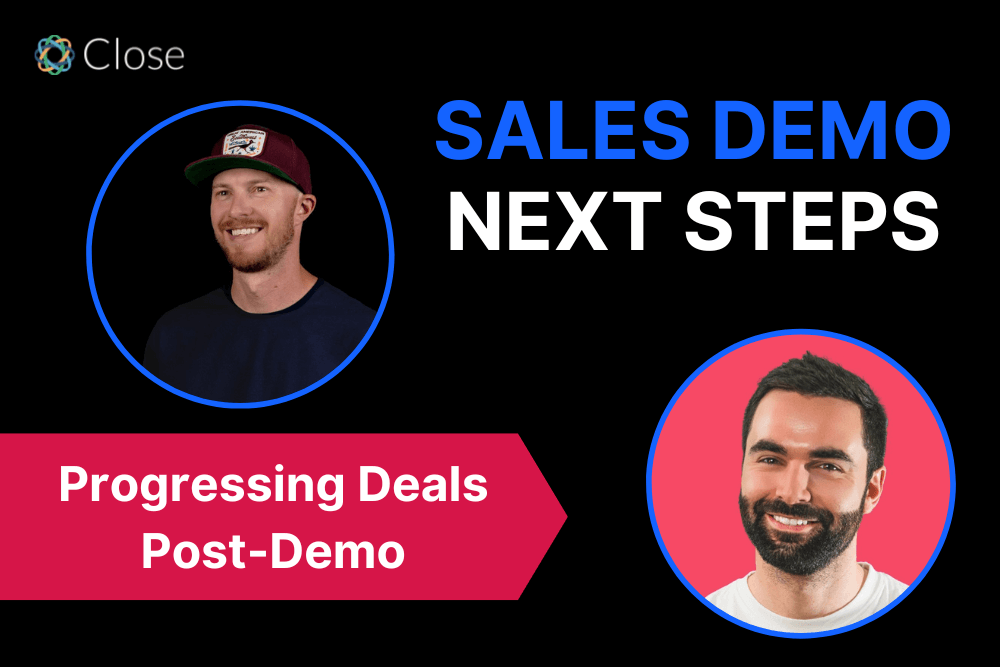
Your product demo is done. You know you nailed the whole thing, start to finish. The prospect was blown away by your product.
Now it’s time to sit back, relax, and wait for the money to arrive.
Or, is it?
You can ace the entire sales demo process, but if you skip talking about your next steps, you’re looking at a 71% decrease in close rate. Research shows that successful sales reps spend 12.7% more time talking about next steps at the end of the demo.
 |
Your sales demo next steps are just as important (if not more important) than the demo content itself.
Want to learn more about these SaaS sales demo best practices? Keep reading:
How to Progress Your Deals Post-Demo in 7 Steps
You’ve finished your demo on a high. Keeping that momentum through the final stages of the sales process is key to closing the deal. So, here’s your step-by-step process to keep deals moving forward and to shorten your sales cycle after the discovery call and sales demo:
1. Listen Back to Your Recorded Call
It’s so easy to finish a call and assume you heard everything. But there are so many times when you were too focused on taking notes, or you were excited about sharing product features … and you missed things.
Listening back to your sales demos may not seem like an immediate priority, but this is a key method to make sure you’re truly aligned with your prospect and everything they said during the call.
Want to make this process faster? Use conversation intelligence tools with AI functionality that provide insights into your calls, like Gong or Jiminny.
Looking to jazz up your discovery meetings and make them engaging? Dive into our article on "Sales Discovery Meeting Blueprint: 7 Steps to Enhance Client Relationships" for some fresh ideas.
2. Send a Demo Follow-Up Email
This may seem obvious, but remember that not all demo follow-up emails are created equal.
If you’re sending the slide deck, case studies, links to blogs, Calendly, and other documents all at once, that’s not going to help anyone. That’s information overload. And while automation can help you send more of these emails at scale, remember that personalization is essential.
Use your follow-up email to summarize key points, including:
- How your product can solve the prospect’s challenges
- Why this is a fit for their team
- A recap of pricing
- Clear next steps that were discussed on the call
Here’s a script I use, either at the end of the call or in that follow-up email:
“I’m penciling in 15 minutes in a week’s time, just so we can go through what I’ve shared.”
Don’t ask, just go for it. Have confidence that this is something beneficial to both parties.
3. Align Early on Their Procurement Process
If you’re still only speaking to one internal champion at this point, you need to ask yourself: “Do I know who else will be involved in making this deal happen?”
When setting up next steps, there may be five people who need to do 20 different things to get this deal closed. Decision-makers and stakeholders need to be brought on board. You probably need to navigate the Legal, Procurement, and Security teams, each with its own requirements and needs.
Don’t assume that because one person is excited, they will make this deal happen. In fact, many buyers are unsure of how exactly their own company’s procurement process works.
How can you fix this? Preempt the roadblocks in this process by asking the right questions early on.
Here are some simple scripts we use to nail down this process and get the right people involved:
“In a typical purchase process for a company like yours, you’ll need to get this past Legal. What can we do for you to address any questions that will probably pop up?”
“It sounds like you’ve purchased software before, and you know it can cause a headache. Let’s explore this now with the hope that we’re working towards getting something implemented.”
“Typically, with companies of your size, we see X, Y, and Z are needed for the procurement process. Do you need any of these? We’re happy to get that ready for you.”
“X will probably come up, and we don’t want it to delay things. I’m sharing these things with you now, and I would recommend sharing this with your team in Legal. Or, I can pick it up directly with them if that helps. I know you’re busy, I don’t want to add to your workload.”
4. Create a Mutual Action Plan
You need to get the deal closed. Your prospect needs to solve a pain point. So, rather than simply drawing up a templated proposal, talk about how this is going to happen.
Creating a mutual action plan is a great way to simplify your next steps and make the path to purchase crystal clear.
Lay out what each party needs to do next. What’s the timeline? What are the steps involved? What do you expect your prospect to do so you can keep moving the deal forward?
After asking them about their company’s procurement process, you should have a better idea of what needs to be done, and who needs to be involved in doing it.
When you highlight clear next steps for your prospect, it creates accountability and removes friction in reaching a closed deal.
5. Bring Success into the Conversation Early
 |
You have expectations for your potential customer—now, what can they expect from you in return?
In this stage, it’s important to start introducing the people who are going to help onboard and train the new customer, including your Success team, account managers, an onboarding specialist, a support engineer, etc.
This shows commitment from your side. Basically, you’re telling your prospects that you will continue to support them on their journey toward solving the pain point.
6. Be Transparent With Comparisons
Due diligence is normally an important part of any B2B purchase. By the time you start a demo call, your prospect has probably done 80% of their research. And they’re probably still looking at other solutions.
So, invite the elephant into the room.
Here’s a template of how it can go:
“We know we’ve got competition. Don’t worry—I’ve done some research for you. Here’s a really transparent comparison that you might want to share with your team. I get it, your CFO’s going to ask if you looked at other tools. So you can share this honest comparison of pricing, features, support, onboarding, and other things you care about.”
Don’t avoid this conversation. Embrace it, and you’ll get ahead of those objections.
7. Give Buyers the Right Information at the Right Time
Sequencing out the information your prospects need is always better than sending an email with 20 attachments and a GIF directly after your demo.
Think about the buyer: They just got off a 30-minute call, and they’re pretty tired. Throw 20 documents at them, and they’ll probably push it to next week.
Instead, feed those necessary items into the journey as it progresses.
If you’ve already booked a follow-up meeting (and you should have), you can then move on to the Ts and Cs, the legal, procurement, security, and all of that.
Close More Deals With Your SaaS Product Demos
As an account executive, setting up a post-demo workflow can take time. And, of course, it will be slightly different for each new customer.
But with a strong routine for aligning with their buying process, providing support and transparency, and giving them the right info at the right time, you’ll have a more solid, clear path to the finish line for each new deal.
The right tools will help you do that.
The premise of Trumpet is to centralize buyer journeys and link everything you need in one place. It creates a central space that sellers can refer back to, while equipping buyers with something they can share internally.
And when tracking touchpoints and executing outreach to buyers, there is no better tool than Close.
Curious about Trumpet? Check us out here.









